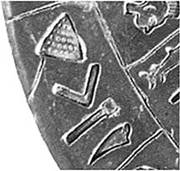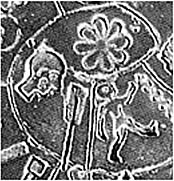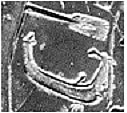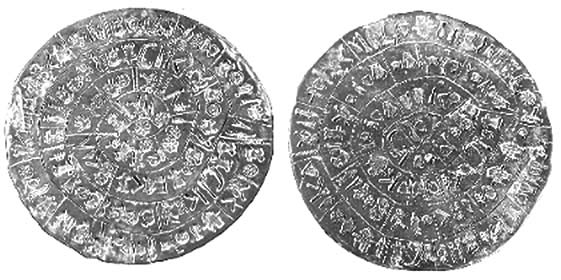Phaistos disc - A new interpretative approach
© 2007 by Sidus – all rights reserved
In the old continent the most ancient document containing symbols of a very old martial or sacerdotal-martial initiatory tradition (according to some authors – see note 1 - the so-called ‘chivalrous path' of the initiatory journey) is undoubtedly preserved in the Archaeological Museum of Herakleion; it is the Phaistos Disc, finding of a prestigious Italian archaeological mission at the beginning of the twentieth century (see note 2) .
The Disc's dating is uncertain, but it can definitely be placed between the seventeenth and the fourteenth centuries B.C.; it has never been coded and studied from a traditional point of view (by tradition we mean the whole heritage of sacredness, symbolism and rituality that derives – trans- ductum – from all the religions and the mysterial cults that have crossed every era of the world). It contains many symbols shared by the Freemason initiatory Tradition, in a spiral-shaped journey (fig. 6) that from the periphery goes to the center through two paths represented on the two sides of the disc; the second one is likely to end with the achievement of the Great Mysteries, viz. the top of the spiritual achievement for any Tradition of Self: only at the end of the second journey the warrior appears tattooed on the cheek (fig. 2) with an eight-shaped sign, double circle of spiritual achievement and magnification of war courage.

Figure 1 :
triangle, square, mallet and knife |

Figure 2 :
tattooed head with an eight on the cheek and eight-petaled flower |
Then the two (see note 3) appears (double circle) in the concept of symbol of conflict and war but also of final balance, representing the dynamic motion that starts every evolutionary process.
Let's remember that a few decades ago even Carl Gustav Jung and his school took interest from a psychoanalytical point of view into the symbolic meaning of the tattoo as an initiatory sign (see note 4) ; they considered it as a part of the signs regarding the archetype of initiation , magnification and apotheosis of the Myth of the Hero, who from the lowest level of original identity mother-child or ego-Self , through symbolic death is reborn and redeems himself, achieving a prominent position of his own Ego winning on the needs of the Self that is still primitive.
But what leads us even farther and allows us to hypothesize links with other Mysterial Cults of ancient times is the analysis of the eight-shaped sign tattooed on the warrior's face; eight is also the number of Cabeiri (see note 5) (the eight Gods that served the great Phoenician Goddess, nurse of the living), which represent the Strong, the Powerful. Cabeiri were invoked when the elements broke out and sailors relied on their protection during storms; the cult of these deities was transmitted to the Greeks, who started the Mysterial Cult of Samothrace in their honor. The number eight (in Phoenician Hhet,  , eighth letter of the primitive alphabet) is found in the Babylonian emblem of the sun, whose rays split in a double cross ( see note 6 ).
, eighth letter of the primitive alphabet) is found in the Babylonian emblem of the sun, whose rays split in a double cross ( see note 6 ).
It is interesting to observe how on the side of the disc where the image of the tattooed man appears, there is also the image of a bird (possibly an eagle for five times (as many concentric circles there are in the Phaistos Disc) which holds/transports the double circle that appears tattooed on the cheek of the warrior. The eagle always appears accompanied (immediately preceded or followed) by the flaming sword and a shield (the latter 4 times out of five where the eagle appears) and this would hint at the protection that the initiatory sign owns thanks to the hierophant priest-teacher who initiates (the flaming sword in the ritual of initiation to Freemasonry electively arms the right hand of the Venerable Master who rules the ceremony and initiates the profane).
Surprisingly in this ancient 16cm circa round table made of very good clay (made of a very fine grain) it is represented a writing not comparable to any other of the time; we think this is because a pure initiatory language is represented; in it we can find an extraordinarily close, if not identical (at least for certain signs) semiotics to Masonic symbolism. Square, compass, mallet, gloves, flaming sword (fig. 3) but also other signs comparable to Freemasonry tradition, such as the rhyton (fig. 3), the ‘libations' chalice' of the time, the man with his hands tied behind his back (the so-called ‘prisoner' (fig. 4) of the archaeologists who ventured in the rough land of a perfunctory interpretation) that refers to the preparation of the initiate but also to the symbol of water, eight-petaled flower (fig. 2) instinctively approachable, although this comparison sounds anachronistic (but Guènon suggests that the law of correspondences has no limits!) distinctive sign of the forget-me-not (this is a 6-petaled flower) of more recent Germanic heritage, to the top of the first initiatory journey.

Figure 3: shield and flaming sword; compass; flower and rhyton; glove.
We also have the child (innocence, purity, simplicity), the club (the weapon of Herakles, the first initiate, through all the trials), the animal skin , that perhaps here is indirectly connected to the meaning of the dispossession of metals (cf. John Baptist only dressed with camel's skin ( see note 7 ), but also the shield , (fig. 4) and the rudder (fig. 5) that protects and guides during the whole initiatory process, a role carried out by the Expert in Mason Initiation.

Figure 4: prisoner
|

Figure 5: ship's rudder |
Another interesting sign that often appears in both sides of the disc is a boat (fig. 5) with only one traveler inside it in the dangerous sea of initiatory trials. We find frequent references to navigation in Dante Alighieri, from the De Monarchia to the Divine Comedy ; the ship as a symbol of Gianus has been changed by Catholicism as a symbol of Peter; such symbolism, as Guènon suggests, was often used in ancient times by Greeks and Romans. For example we can mention the Argonauts, Homer and his Odysseus, Virgil and the Aeneid up to Ovid. This image can be found in India as well; here is a sentence by Sankaracarya: ‘the Yogin, once crossed the sea of passion, is joined to tranquility and owns his Self in its wholeness'; a similar hieroglyph in the shape of a ship had a meaning of navigation in ancient Egypt .
Finally we must mention the representation of a triangle (fig. 1) with its vertex pointing to the bottom – in relation to the most external circle of the rough manifestation to which it refers – which appears only once in the most external spiral of the first journey, next to the square, mallet and a knife , with many dots in relief, which archaeologists have compared to the representation of a ‘filter' or colander. We are skeptical towards this simplistic view, therefore we would relate it to the knowledge of Pythagorean numerology, such as the Tetraktys (see note 9) , the triangle containing ten points placed as 1, 2, 3 and 4; it demonstrates how the number 4 generates the number 10 (1+2+3+4=10). Phaistos triangle, though, is made of a group of six points (fig. 1) for each side where the Pythagorean one has 4; this could originate further numerological reflections.
The idea that it is an initiation to remote mysterial martial cults is taken from the presence in the disc of many representations of man's heads with a crest-shaped helmet. Evans (the discoverer of Knossos) compared these figures to the representations of the peoples of the sea (Philistines) on the walls of the temple of Ramses III in Medinet Habu who have heads similar to those in the disc ( see note 10 ); the warrior, once abandoned the helmet, in his final journey finds himself completely shaved (there is the parallelism with the act of tonsure on the novices, kind of initiatory rite of renunciation of all the earthly things for the final marriage with Christ. The Rite of tonsure is also present among monks and priests in the Middle Ages as well as among the ancient Greeks and Romans, where the offer of the hair was a sign of dedication, commitment and repentance, but also in the event of acquisition of citizenship and in nuptial and funereal ceremonies ( see note 11 ) with a tattoo (fig. 2) in the shape of an eight on the right cheek, distinctive sign of the belonging to a warrior initiatory order. It is inevitable to link this ancient initiatory Order to the more famous and recent military-sacerdotal initiatory Order of the Knights of the Temple, inside which there was a rigid rule and a ritual of initiation unfortunately unknown in detail apart from a few particulars extorted through torture and used in a defamatory way by the papal court and by Philip the Fair to condemn the Order.
Of course to venture on the rough grounds of interpretative approach on the whole of signs and their disposition inside the spiral of the Phaistos Disc is very risky and difficult. Naturally beyond the esoteric suggestions that the Disc can evoke, there are other signs which haven't been mentioned and that cannot be easily compared to our esoteric Tradition; we believe that their meaning is irremediably lost in the secret of the Mysterial Cults they referred to.

Fig. 6: Phaistos Disc. Archaeological Museum of Herakleion .
--------------------
Notes
(1) La Tradizione del Sé. ( The Tradition of Self) Alberto Samonà. Atanor 2003, pages 11-16.
(2) Il Disco di Festo. L'enigma di una scrittura. ( Phaistos Disc. The enigma of a script) Louis Godart. Einaudi, 1994. Pages 7-20.
(3) number 2, which Hebrew cabbala links to Wisdom ( Hokmah ) to the creating thought, to the immediate emanation of the Father, to the Logos and Supreme Reason. For Pythagoreans the number two was considered the first real number because it represents the first plurality . The number two in the Prisca Philosophia (The most ancient Tradition) is also symbol of splitting, separation, disagreement, contrast and conflict (similar to war) but also of final balance, symbolizing the dynamic motion that starts any process of evolution. In conclusion the number Two is the number of Wisdom-Spirit-Logos-Supreme Reason but also Conflict, such as thesis and antithesis that generate the eternal motion of becoming. In the number two there are all the dualisms of tradition: black and white, good and bad, light and shadow, virility and femininity, day and night, earth and sky, Yin and Yang.
(4) Man and His Symbols. CG Jung & Coll.
(5) La Massoneria III. Il Maestro. ( Freemasonry III. The Master) Osvald Wirth. Atanor, 1992. Pages 144-146.
(6) Ibid.
(7) New Testament. Matthew: III, 4.
(8) Spiritual Authority and Temporal power. René Guénon.
(9) La Massoneria II. Il Compagno. ( Freemasonry II. The Fellowship) Oswald Wirth. Atanor, 1992, page 104.
(10) Il Disco di Festo. L'enigma di una scrittura. (Phaistos Disc. The enigma of a script) Louis Godart. Einaudi, 1994, page 89.
(11) Symbols ( Herder Lexikon.Symbole : Verlag Herder -Freiburg)